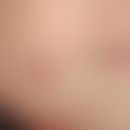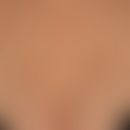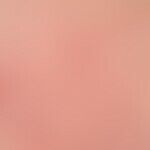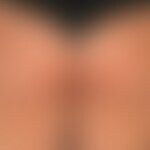Synonym(s)
HistoryThis section has been translated automatically.
DefinitionThis section has been translated automatically.
Maculopapular cutaneous mastocytosis (urticaria pigmentosa of the old nomenclature) is by far the most common type of cutaneous mastocytosis. The early childhood forms of cutaneous mastocytosis often correspond to the clinical picture of solitary or multinodular mastocytoma.
The purely descriptive clinical picture of maculopapular mastocytosis is based on a clonal disease of the CD34+ hematopoietic stem cell in the bone marrow with the development of clinically distinct clinical pictures, which are characterized by mast cell proliferations in the skin (and possibly also in internal organs - especially bone marrow, lymphatic organs).
In (monoorganic) cutaneous mastocytosis of the maculopapular cutaneous mastocytosis type, the proliferation of mast cells is restricted exclusively to the skin.
In systemic mastocytosis, the skin may be involved; however, it may occur without any skin involvement (the skin changes correspond to the clinical picture of maculopapular cut aneous mastocytosis or diffuse cutaneous mastocytosis). Systemic mastocytosis often begins in adulthood, more rarely in childhood. In childhood, this manifestation form may start as "monoorganic cutaneous maculopapular mastocytosis" and then become systemically relevant in adulthood as "indolent systemic mastocytosis".
The clinical symptoms of systemic mastocytosis are heterogeneous depending on the manifestation type(indolent systemic mastocytosis/advancedsystemic mastocytosis) and depend on the mast cell load. Anaphylactic reactions and other reactions triggered by mast cell mediators such as flushing symptoms, pruritus, urticaria, asthma attacks, abdominal complaints such as diarrhea or gastrointestinal ulcers as well as joint and bone pain characterize the clinical picture.
You might also be interested in
ClassificationThis section has been translated automatically.
Maculopapular cutaneous mastocytosis = disseminated mastocytosis; 5 mastocytomas = maculopapular cutaneous mastocytosis
- Maculopapular cutaneous mastocytosis of the adult
- Maculo-papular cutaneous mastocytosis (Urticaria pigmentosa of the old nomenclature )
- Teleangiectasia macularis eruptiva perstans
- Maculopapular cutaneous mastocytosis (urticaria pigmentosa of the old nomenclature) of childhood
- Maculopapular cutaneous mastocytosis (classic type)
- Teleangiectasia macularis eruptiva perstans (extremely rare in childhood)
Occurrence/EpidemiologyThis section has been translated automatically.
No gender preference. In childhood the incidence of cutaneous mastocytosis is 1:150,000 per year
EtiopathogenesisThis section has been translated automatically.
Most adult patients with this skin manifestation have an activating point mutation of the KIT gene (KIT D816V). Both the expression of KIT (CD117) on the cell surface and the mutation are not specific for mastocytosis - see below Mastocytosis (overview).
In childhood maculopapular cutaneous mastocytosis, the activating c-Kit mutation is not detectable.
ManifestationThis section has been translated automatically.
In childhood maculopapular cutaneous mastocytosis, the initial manifestation often occurs in the first 24 months of life, less commonly thereafter.
In the adult form (maculopapular cutaneous mastocytosis of adulthood), the peak of manifestation is found in middle adulthood (40-60 years).
LocalizationThis section has been translated automatically.
Ubiquitous; mainly on the trunk and upper and lower extremities; rarely on the face, palms of the hands and soles of the feet. Very rarely mucosal involvement.
ClinicThis section has been translated automatically.
Flat, oval or round, gray-brownish or red-brownish, 0.1-0.5 cm spots. The clinical symptomatology of the patients is due to release of the various mast cell mediators (mediator symptomatology). Besides histamine, tryptase, heparin, leukotrienes, prostaglandins as well as various cytokines such as TNF-alpha, interleukins. After firm coating of the lesions, there is an urticarial reaction in the foci(Darier's sign); more rarely, subepidermal blistering. Frequently, elevated dermographism can also be induced. Initially weak, later more severe lesional pigmentation. The most frequent accompanying symptom is pruritus, with interleukin-31 being attributed particular pathogenetic significance (Wagner N et al. 2018).
Regarding the clinical course, juvenile and adult formers behave differently.
Special forms (old nomenclature):
LaboratoryThis section has been translated automatically.
In case of systemic mastocytosis, tryptase is determined according to the guidelines (standard value: <20µg/l). If the value is exceeded, systemic mastocytosis is considered possible and a bone marrow biopsy and screening for further system involvement is sought. If the values are low, extensive diagnostic procedures are usually not necessary without compelling clinical indications. In a larger study, systemic mastocytosis was confirmed in 32% of patients with cutaneous mastocytosis in bone marrow histology. The mean tryptase value of the collective with system involvement was 43.9±39.93µg/l (3.74-173µg/l), without system involvement 19.63±13.31 µg/l (2.44-54 µg/l).tryptase increases > 20µg/l were detectable in 43% of patients with pure cutaneous mastocytosis. 28% of patients with systemic mastocytosis showed normal values. Thus the laboratory value "tryptase" does not seem to be a reliable parameter for the question of systemic involvement.
In addition, the determination of N-methylhistamine or 1,4-methylimidazole acetic acid in the collective urine can be performed.
HistologyThis section has been translated automatically.
Often not very spectacular histological image in HE-stained specimen. Discrete hyperpigmentation of the otherwise unchanged epidermis. Shattered, perivascularly accentuated round cell infiltrates in the reticular dermis. The mast cell-rich quality of the infiltrate (Giemsa staining; CD117; CD25) is only recognizable with histochemical or immunohistochemical imaging.
Differential diagnosisThis section has been translated automatically.
malignant cutaneous lymphoma;
urticaria
Drug exanthema
TherapyThis section has been translated automatically.
Symptomatic, s.a. mastocytosis diffuse of the skin.
General therapyThis section has been translated automatically.
Patient education about the nature of the disease and provoking factors. Avoidance of triggering drugs such as non-steroidal anti-inflammatory drugs, acetylsalicylic acid, codeine, procaine, polymyxin B, muscle relaxants, X-ray contrast media. No mechanical irritation such as friction (dry rub) or sudden temperature changes (jumping into cold water). Avoid insect bites. Caution. Triggering by i.v. applied, short-acting narcotics is possible!
Diet: A low-histamine diet, possibly also a low-salicylate diet, is recommended, see below. Urticaria, chronic. Histamine relievers should be avoided.
External therapyThis section has been translated automatically.
Radiation therapyThis section has been translated automatically.
Internal therapyThis section has been translated automatically.
Antihistamines: Combinations of a non-sedating H 1 -antagonist such as levocetirizine (Xusal) 1 time/day 5 mg p.o. or a sedating H 1 -antagonist such as dimetindene (Fenistil) 3 times/day 1-2 mg p.o. with an H 2 -antagonist such as cimetidine (e.g. Tagamet) 400-800 mg/day p.o. are used. S.a.u. Mastocytosis, systemic.
Mast cell stabilizers (e.g. ketotifen (e.g. Zaditen Kps./syrup): Adults: 2 times/day 1-2 mg p.o., children over 3 years: 2 times/day 1 Kps., children from 6 months to 3 years: 2 times/day 2.5 ml syrup.
In individual cases, improvement is achieved with disodium cromoglicic acid (e.g. Colimune) 4 times/day 100-200 mg.
Glucocorticoids: In severe forms, including bullous forms, glucocorticoids in medium doses such as prednisone (e.g. Decortin) 40-60 mg/day may be considered, with gradual dose reduction to the maintenance dose according to the clinic.
Experimental approaches with positive results exist for omalizumab (Xolair), an IgE antibody.
Progression/forecastThis section has been translated automatically.
Favorable. >95% of patients have a normal life expectancy.
In>50% of juvenile cutaneous mastocytoses, spontaneous remission occurs by adolescence. Systemic involvement can be detected in 10% of children. Especially in children with a later first manifestation (>years). Clinically, systemic involvement may be manifested by diarrhea, flushing, headache, and bone pain.
In adult cutaneous mastocytosis, the disease is usually chronic and insidiously progressive. Only a small proportion show remissions. Systemic involvement is observed in about half of the patients. Systemic involvement: Mast cell infiltration is observed in bone marrow, liver, spleen and/or lymph nodes) and manifests in a variety of organ disorders such as: gastritis, ventricular or duodenal ulcer, flush, malabsorption syndromes.
TablesThis section has been translated automatically.
Antihistamines for Urticaria pigmentosa
Active substance |
Example preparation |
Age |
Dosage/day |
Application |
|
Non-sedating |
Cetirizine |
Zyrtec |
2-12 J. |
½-1 Mßl. |
Syrup |
> 12 J. |
10 mg |
fimtbl. |
|||
Levocetirizine |
Xusal |
> 6 J. |
5 mg |
Filmtbl. |
|
Loratadine |
Lisino |
2-12 J. |
½-1 Mßl. |
Syrup |
|
> 12 J. |
10 mg |
Tbl. |
|||
Desloratadine |
Aerius |
2-5 J. |
2.5 ml (1.25 mg) |
Syrup |
|
6-12 J. |
5 ml (2.5 mg) |
Syrup |
|||
> 12 J. |
10 mg |
Filmtbl. |
|||
Doxylamine Succinate |
Mereprine |
½-5 J. |
1-2 times 1 teaspoon. |
Syrup |
|
6-12 J. |
2-3 times 1 tsp. |
Syrup |
|||
> 12 J. |
2-4 times 2 teas. |
Syrup |
|||
| |||||
Sedating |
Clemastine |
Tavegil |
1-6 J. |
2 times 1-2 teas. |
Syrup |
6-12 J. |
2 times 1 tbs. |
Syrup |
|||
> 12 J. |
2 times 1 mg |
Tbl. |
|||
Dimetinden |
Fenistil |
1-8 J. |
3 times 1 teaspoon. |
Syrup |
|
LiteratureThis section has been translated automatically.
- Arber DA et al (2016) The 2016 revision to the World Health Organization classification of myeloidneoplasms
and acute leukemia. Blood 127:2391-405. - Czarnetzki BM et al (1985) Phototherapy of urticaria pigmentosa; clinical response and changes of cutaneous reactivity, histamies and chemotactic leukotrienes. Arch Dermatol Res 277: 105-113
- Comte C et al (2003) Urticaria pigmentosa localized on radiation field. Eur J Dermatol 13: 408-409
- Gobello T et al (2003) Medium versus high-dose ultraviolet A1 therapy for urticaria pigmentosa: a pilot study. J Am Acad Dermatol 49: 679-684
- Guler E et al (2001) Urticaria pigmentosa associated with Wilms tumor. Pediatric Dermatol 18: 313-315
- Ludolph-Hauser D et al (2001) Occult cutaneous mastocytosis. dermatologist 52: 390-393
- Nettleship E (1869) Rare forms of urticaria. Br Med J 2: 323
- Nettleship E (1869) Chronic urticaria leaving brown stains: nearly two years' duration. BMJ 2: 435
- Requena L (1992) Erythrodermic mastocytosis. Cutis 49: 189-192
- Sangster A (1878) Urticaria Pigmentosa. Lancet I: 683
Incoming links (27)
Advanced systemic mastocytosis; Biopsy; Brown man; Cutaneous mastocytoma; Cutaneous mastocytosis; Cutaneous mastocytosis of adulthood; Cutaneous mastocytosis of childhood; Darian sign; Diffuse cutaneous mastocytosis; Facial erythema; ... Show allOutgoing links (44)
Acetylsalicylic acid; Advanced systemic mastocytosis; Antihistamines; Antihistamines, h2-antagonists; Antihistamines, systemic; Bubble; Cd117; Cd25; CD classification; Cimetidine; ... Show allDisclaimer
Please ask your physician for a reliable diagnosis. This website is only meant as a reference.











































